WASHINGTON, DC
September 11, 2016
STRANGER: Brad Rushing
LOCATION: Fare Well, 406 H Street NE, Washington, DC
THEME: Chatting with a cinematographer
There are several sides to Brad Rushing.
First is the successful cinematographer, the man who scooped an MTV Video Music Award for his work on the video for the Moby song “We Are All Made Of Stars;” who has worked with other stars such as Britney Spears and Nelly; who speaks of days filming at the Playboy Mansion and hanging out on set with well-known actors.
Second is the affable, sweet-natured man who is a fascinating dining companion; who has an endearing inquisitiveness on everything around him; who has a genuine interest in learning more about others; and who doesn’t seem to say anything negative.
Third is the painfully shy man who’s struggled with being outgoing since childhood and the time as a small child when he burst into tears when his mother told him to go order a soda without her help; who has had to bury that anxiety in the world of Hollywood where professional success is as much to do with personal connections as a proven track record.
And there’s the science and arts geek who wore a colorful Vincent Price t-shirt to dinner with me and from that riffed with our waitress about Comic-Con.
Put them together and you’ve got a compelling interviewee, and for almost two hours during a recent dinner in Washington, DC, I learned about all about Brad.
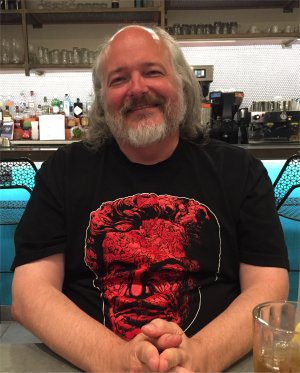
We met at Fare Well, a new restaurant on H Street NE that’s seen a host of independent bars, restaurants and shops popping up in the last few years.
The brightly lit venue is relatively small, with a long bench lining one wall divided into several tables. The close quarters mean that there’s not a lot of privacy, and during the interview I got distracted a little by the conversations to the left and right of us. But the ambient noise level is generally decent, and without obtrusive music playing.
Brad, 51, was visiting DC from Los Angeles and had suggested we dine at Fare Well because it’s focused on vegan and vegetarian food, and that’s his diet. Although I’m a meat eater, I was happy to comply and intrigued by the menu.
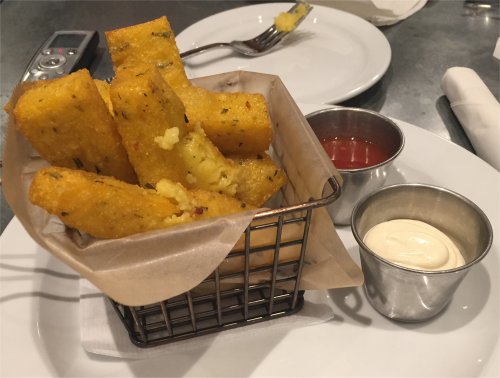
To start our meal, we ordered some polenta fries served with garlic aioli and tomato jam. Thicker than the usual potato fry, there were only a few but that was more than enough. Perfectly fried (crispy shell, fluffy interior) and the jam was delicious. We both tucked in to the snack as Brad answered that most DC of questions: “What do you do?”
I was curious about what the work of a cinematographer (or director of photography, as he’s also known) entails, and Brad was happy to elaborate.
We toasted our drinks: An iced tea for him, a “Queen of H Street” cocktail for me (vodka, raspberry puree, thyme, lemon, white tea simple syrup, egg white substitute). And then he continued.
“My domain is camera and lighting,” he said. Brad said he prides himself on being able to “reverse engineer” any style that his client wants, figuring out exactly how to arrange the camera angles, visual references, and lighting in order to achieve the required look. If someone shows him a picture of a certain ambience or style, Brad has the years of experience necessary to achieve exactly what they’re looking for.
Brad has an art background from his school days in his home state of Texas, and said that it’s been invaluable in helping build his cinematography repertoire.
“I have deliberately built a broad collective range, because I don’t want to be the guy who just does one style,” he said. “In this business fashions move in and out of favor very rapidly, so if you’re the guy known for one look, the day that looks goes out of style, you’re out of a job.”
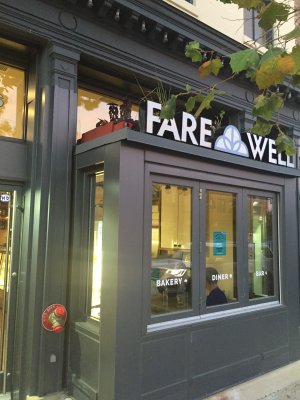
Another perk of having a diverse portfolio is that he can work on a broader range of projects, from commercials to movies and television shows in a host of genres. Want a dark, gloomy look for a horror movie? Or a bright, poppy colorful advertisement? Brad can do either, and more. He achieves this through logistical decisions such as which angle to shoot, which camera and lens to use, whether to back-light the scene, and how to manage seemingly impossible shots.
For example, Brad described the movie “Tomorrow By Midnight” that he shot with the late Alexis Arquette. “The movie takes place almost entirely in a single one room set. I was very conscientious going into it that the single set could be terribly boring visually. So we broke the story down into phases and for each one I created a lighting look appropriate to the mood of the story, and the transitions would occur through the actions of the characters,” he said. “Even the paint on the walls of the set was designed to enhance the mood since in the beginning all characters are standing at eye height, so the camera sees a certain colorfully painted portion of the wall and towards the end there are a lot of shots with some characters on the floor and others standing over them in those angles the set walls and floor are more monotone.”
Then there’s the music video for “Chrysalis Heart” by Delerium, which required a time-lapse shot of a clock. Summarizing the problem that needed solving, Brad said, “That would have taken hours to photograph and the light would have moved across it in a way which was uncontrollable to us. It would not have moved across this wall in our set in the way we wanted.”
His solution was to first shoot a clock without hands in real time to get the effect of the changing light. “I manually moved a light across the clock by holding the stand with my hands and swinging it through the air. Then the spinning hands were added as a visual effect,” he said. Watching the clip, it looks great — even more so knowing how it was achieved.
“Each one of these is an example of invisible movie magic which the audience should never notice, but for which an incredible amount of thought, planning and effort went into making a seamless part of the viewing experience,” Brad said.
His work has scored him accolades including the aforementioned MTV Video Music Award for Best Cinematography for Moby’s video in 2002, and a 2005 Canadian Society of Cinematographers Award for Best Music Video Cinematography for the video for Alsou’s song “Always On My Mind.” But these potential ego boosts don’t drive him, instead he just loves his work.

While I sipped on a “Last Word” cocktail — gin, green chartreuse, maraschino liqueur, lime — Brad told me what it is about being a cinematographer that keeps him interested.
“There is so much wizardry in what I do,” Brad said with a smile, as he enjoyed a bowl of the daily soup special. It was what he called a “phenomenal” potato and corn chowder.
If he’s a wizard, then his Hogwart’s School of Witchcraft and Wizardry was Houston’s independent High School for the Performing and Visual Arts (HSPVA), where he said he believes he got most of his “foundation” that led to his eventual career.
Brad was born in Houston on October 27, 1964, and grew up on the south side of the city with his younger brother and sister. His father was a metallurgical technician, while his mother — a Canadian who had previously studied physical therapy at the University of Toronto and worked in that field — became a full-time housewife to look after the kids. “She loved her work and was very good at it. But in those days many women felt they had to choose between a career and a family. Selfishly I loved having my Mom full time. As an adult with a career I love I understand the sacrifice she made for us to have that experience. I do believe she ultimately felt it had been worthwhile. She really loved her family very much,” Brad said.
Growing up in the ’60s Brad was immersed in what he called the “wonderful” world of space and science fiction, including television shows such as Dark Shadows, Star Trek and Lost in Space. He described an “eventful” childhood “with many, many happy memories. We took trips around Texas and out of state, to museums and parks. In 1975 my family drove to Cape Canaveral where we watched the final lift off of the Apollo Space program with the launch for the Apollo-Soyuz mission. We had close family, part of whom were Czech, Canadian and Lebanese. So we had a beautiful cultural diversity built in. My parents encouraged all the kids’ artistic abilities and worked hard to involve us in significant cultural events of the time.”
He always enjoyed art and drawing, a hobby that stuck with him through high school. And he loved science because he’s a self-confessed geek and because of the era he grew up in, when space exploration was in the headlines.
“But I was always very shy, painfully shy,” Brad added. “I have this distinct memory of my mom trying to break me out of this. She took me to a 7-11 and gave me money and told me to go and buy a Slurpee. I was so terrified I just sat in the car and cried.”
It’s hard to believe that story when meeting Brad, because he’s so outwardly sociable and chatty, and always smiling and joking. But he said that even today he’s still a naturally shy person, he’s just gotten better at masking it over the years. “In the business I’m in, you have to overcome shyness or you die. At some point I realized my shyness was costing me work, so I just had to work through it.”
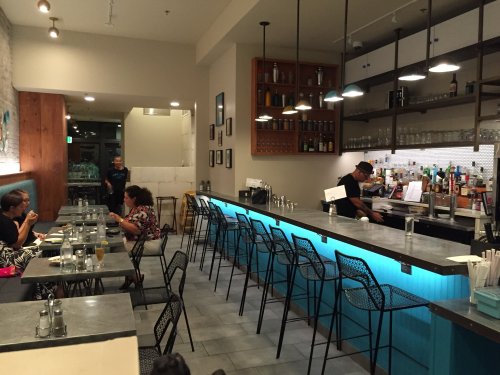
During high school he wasn’t “a great student” but finally found inspiration once he enrolled at HSPVA. “I could indulge my love of arts, of music, of science, all in one place,” he said. “Something I would learn years later is that cinematography is the intersection of arts, science, history and music. So I didn’t know it then, but all those things I loved would come together in my work.”
At other high schools, Brad had been turned off by the cliques like the jocks or the cheerleaders. At the performing arts school, he loved the broad mix of white, black, sporty, nerdy, straight and gay. “It was just this great big stew of creativity and was a wonderful experience to be seen for who I really was.”
Nevertheless, he remained shy all through high school and his time at the University of Houston, where he studied from 1982 to 1986. He started as a fine art major with a minor in film, but flipped the major and minor after worrying that being a fine artist would leave him struggling financially the rest of his life. “But I still was, quite frankly, not the best student,” he said.
Our waitress returned at that point with our entrees.
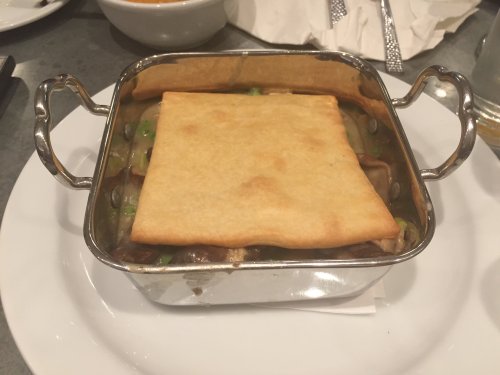
Brad had the truffled pot pie of potato, leeks, soy curls, peas, mushrooms, gravy, truffle dust, flaky crust. “I can’t really taste the truffle,” he said, “But it’s still great.”
My omnivore leanings pushed me in the direction of the dish that seemed most like meat. The seitan platter featured southern fried seitan, crispy potato cake, sautéed seasonal greens, herbed mushroom gravy. Pretty much fried chicken and mash but done vegan-style.

I’m not ready to give up meat based off this meal, but I did not go home hungry that night nor leave anything on the plate. The gravy was so flavorful I could easily have thought it was made with beef drippings, the seitan coated in a wonderfully crisp exterior. Excellent stuff.
As we ate, Brad told me about his decision to leave college and enter the world of work. In 1987, a friend told him about a home shopping channel in Houston that needed a video camera operator. Brad jumped at the chance, and his on-the-job training helped him learn how to handle large film cameras on a working set. It would pay $20,000 annually, at that time a “princely” sum. “Between the choice of continuing on at college and paying those bills or having someone actually pay me to operate a camera it was not a difficult choice,” he said.
The set for the show was designed to look like several rooms in a house to show off various products, and the producers apparently gave the young crew leeway in how to shoot the items. “The lunatics were running the asylum,” he laughed. This meant that Brad got to experiment daily with new ideas for the best camera, lighting for a shot, and camera moves. He learned things like pan the camera across a room for a better image. “It was hardly like working for Michael Bay, but it opened up my imagination to the possibilities of camera angles and movements and various techniques like rack focus.”

Eventually the home shopping company went out of business and Brad was looking for his next job. There was an indie film being shot locally, and he began volunteering in various crew positions. “On set when I saw what everyone did I was attracted to the director of photography who was in control of creating and capturing the images. He decided whether a scene would be bright or dark, monotone or colorful and whether the camera would move, and if so how,” Brad said. This type of work appealed to him more than being a director, who has to deal with many issues beyond best capturing images.
In order to build his resume he did some work on local film projects starting in 1988, and then one day in 1990 he decided on a whim to move to Los Angeles. “I trust my intuition even if it tells me to do loopy things, and it just popped into my head to move — just like that,” he said. “The older I get the stronger I feel about following my guiding star.”
He left on July 4, 1990, with the support of his parents, and remembers that the last image leaving Texas was fireworks popping in the night sky as he passed San Antonio. “I felt that was like my send-off.”
The City of Angels was a wakeup call from Brad almost from the minute he arrived. “I had assumed there would be a lot more job opportunities. I didn’t take into account there would also be a lot more people competing for them, and that it’s who you know. I didn’t know anyone. I was handing out demo reels and resumes and it amounted to nothing.”
His shyness meant he wasn’t making the personal connections necessary to find out about work, or to get other work. So he earned money by doing temp work, keeping his creativity going by working on student films and other small projects. “I was around a lot of dreamers and artists, and had an epiphany I’d never make money this way.”
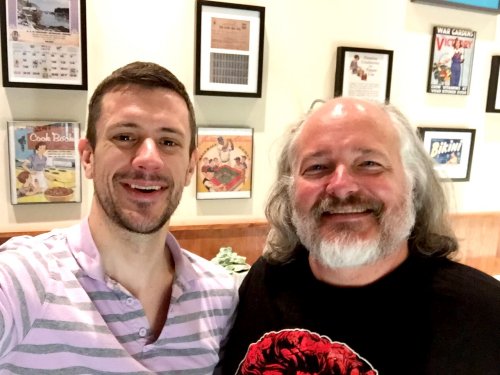
So he decided to make an actual living out of cinematography.
He polished his demo reels and started sending them to companies with a six-pack of beer alongside them in order to make his submission stand out. “I think it cracked some walls, I think it made me unique and got me noticed,” he said, then flashed something between a grimace and a smirk. “I hope I never sent one to an alcoholic.”
Through those submissions Brad started to meet with potential clients, and — unfortunately for someone disposed to shyness — “it proved that this business is all about getting noticed. Talent, great cinematography and wonderful credits can end up just background noise, you need that extra cherry on the top.”
It wasn’t until 1999 that Brad was getting enough work to sustain himself solely as a cinematographer, earning extra cash with camera operating and other work. But just before the millennium he’d built enough of a career and enough contacts that he was able to focus on projects that were singularly about his passion.
Brad was working without an agent until 2002, when he got called up for representation after winning his award for the Moby video. His agent takes 10 percent of his earnings, but Brad had nothing but praise for them. “They negotiate your deals, they manage my calendar, handle any legal issues, all the billing, the paperwork. So if I’m working in London, or Tokyo, or Sao Paolo, I don’t have to worry about any of that.”

His early work in commercials and music videos came about thanks to recommendations from friends, and nowadays most of his work is repeat clients. It’s an impressive roster that has included major corporations and billboard-topping singers.
I wondered at what point Brad felt like he had made it in Hollywood. He cringed and blushed. “Oh god,” he said with a laugh. “I remember the first time I signed with an agent, I went home and played the Beatles’ ‘Baby You’re A Rich Man’ really loudly to celebrate. You know the lyrics, ‘How does it feel to be one of the beautiful people?’ I thought I had made it. In retrospect it’s all rather embarrassing because it seems so pretentious and naive. The truth is I’m always working at it.”
Workloads are cyclical for cinematographers. When Brad won the MTV award and got an agent he was suddenly doing music videos, then that petered out. His work shifted heavily to commercials, promos and branded content which are typically more lucrative. He punctuated that work with indie and art house movies and passion projects, which he said “afford me wonderful and unique creative opportunities.”
But eventually the cycles repeat. “It’s all peaks and valleys,” he said.
“When I got in the very first cycle it was soul crushing and I wondered if I’d ever work again,” Brad added. He’s often busier when he’s not working on a project because he’s out hustling for work, meeting with clients.
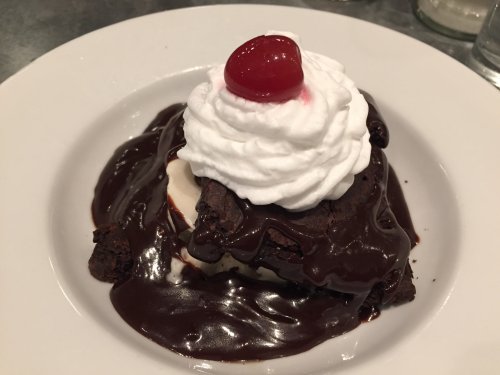
“If it wasn’t for the migraines, I’d be all in,” Brad said.
He wasn’t talking about selling himself in Los Angeles. Rather, his narrative was interrupted by the arrival of dessert. The Jenny’s Big Boy was an imposing bowl of brownie, coconut ice cream, hot fudge, vanilla coconut whipped cream. And it was amazing. Brad is prone to migraines and so he only had a small bit of the treat, leaving me to try and devour the rest of it.
The brownie had thick yet chewy texture to it and strong chocolate flavor, enhanced with each scoop of the subtle coconut ice cream and the delicious fudge. The only negative thing I can say about the dish (perhaps my favorite of the night) was that it was too much to finish alone.
Between spoonfuls, I asked whether Brad ever gets star-struck working in Hollywood.
Brad’s never flustered by famous people he’s met (though he confesses a dream project would be working with Paul McCartney, and he still rues the day his director friend turned down such a gig). But he has praise for the friendliness and professionalism of people he’s worked with, including actors Elliott Gould, Dustin Hoffman and Rutger Hauer.
With fondness, he recalls a film shoot with Mr. Hauer. “I was raising the camera and needed my camera assistant to lock a leg on the tripod, and he does it — then I look up and I see it was Rutger who did it. He didn’t even have to be on set that day, he just wanted to come and join us and have fun, just an amazing guy.”
Brad spoke sadly about the recent death of his former collaborator Alexis Arquette, saying he was “heartbroken about the death of this very fun, talented person.”
In the world of music, Brad also had high praise for singers he’s worked with including Moby, as well as Britney Spears, Eminem, Nelly and many more. He recalls with a smile the time shooting at the Playboy Mansion when Nelly gave each member of the crew of a music video a big hug after it wrapped. Or the unadulterated glee that Eminem had dressing up as different characters like Robin, Sally Jessy Raphael, Elvis and others for the “Without Me” video.

As dinner came to a close, Brad reiterated why he loves his job.
“I get to take part in these culturally defining productions,” he said. “In school, before HSPVA, I was with the geeks and nerds and outcasts. Fast forward, and I’m shooting Britney Spears videos that my peers’ kids are aspiring to. I’m literally creating culture references, cultural iconography. I love taking part in these defining things.”
Cinematography also lets Brad live “multiple lifetimes” by being involved in so many varied projects with so many different story lines.
“My end goal is to drop dead on set in my 100s or 110s,” Brad said. “I can’t imagine ever retiring, I just love it so much.”
q6edqz
l6mydd